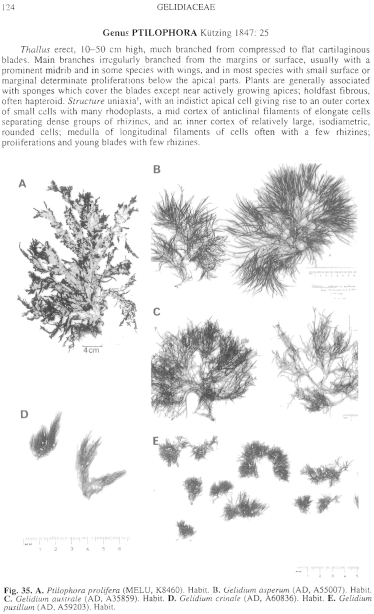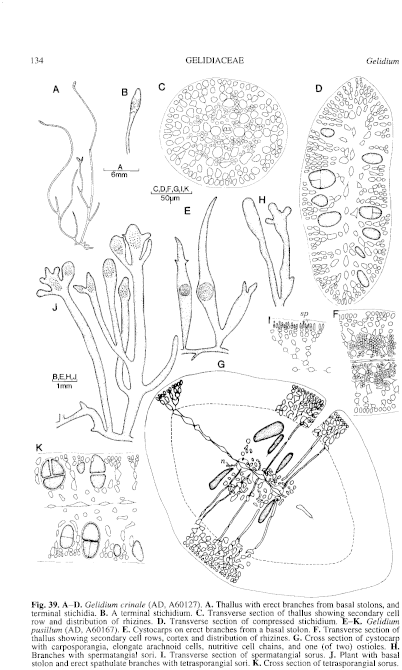|
|
|
|
|
|||||||||||
|
Electronic Flora of South Australia Species Fact Sheet
Phylum Rhodophyta – Class Florideophyceae – Order Gelidiales – Family Gelidiaceae
Selected citations: Santelices 1988: 102, fig. 9. Hatta & Prud'homme van Reine 1991: 364, fig. 8 (for var. pusillum).
Synonyms
Fucus pusillus Stackhouse 1795: 16; 1816: 9, pl. 6 upper right.
Gelidium spathulatum (Kützing) Bornet 1892: 268. Feldmann & Hamel 1936: 115, fig. 21.
Acrocarpus spathulatus Kützing 1868: 13, pl. 36d-g.
Thallus (Figs 35E, 39J) medium to dark red-brown, cartilaginous, forming sparse to dense turfs, (2–) 5–20 (–30) mm thick and commonly 1–4 cm in spread, with prominent prostrate stolons bearing simple to irregularly marginally branched, compressed, erect branches; stolons terete to slightly compressed, prominent, frequently branched, (80–) 200–400 µm in diameter. Erect blades (Fig. 39E, J) at first simple, becoming basally branched to form clusters of simple to subdistichous, flat, blades, (2–) 5–20 (–25) mm high, 200–1000 (–1500) µm broad and 50–100 µm thick [B/T 4–8 (–10)], broadening upwards to a rounded, sometimes slightly depressed apex with a slightly protuberant apical cell, margins of blades straight to slightly undulate. Holdfasts of massed rhizoids 200–600 µm across, sessile or terminating short branches and often below an erect blade; epilithic or on molluscs in pools or subtidally. Structure (Fig. 39F). Outer cortical cells crowded, tending to lie in rows splaying outwards, more or less isodiametric with the protoplast 3–5 µm across in surface view, wall relatively thin; medulla narrow in the flat blades; rhizines present throughout the medulla, mainly in the outer medulla in older branches.
Reproduction: Sexual thalli dioecious. Cystocarps (Fig. 39E) usually single in the mid to upper part of erect blades, round to ovate, 300–400 µm across, with small ostioles on both surfaces. Carposporangia (Fig. 39G) single, pyriform to ovoid, 30–45 µm long and 15–25 µm in diameter; elongate arachnoid cells and nutritive cell chains present. Spermatangia covering the surface of upper parts of relatively narrow erect blades (Fig. 39H), with 4–8 initials replacing each outer cortical cell, cutting off terminally ovoid spermatangia 1–2 µm in diameter (Fig. 39I).
Tetrasporangial sori (Fig. 39J) in upper part of erect blades or laterals, ovate to elongate, 200–500 µm across and 250–1200 (–1500) µm long, with a sterile margin. Tetrasporangia (Fig. 39K) of various ages forming mixed sori, derived from the inner to mid cortical cells in two layers, ovoid, 20–35 µm in diameter, irregularly cruciately (mainly decussately) divided; rhizines confined to edges of tetrasporangial branchlets.
Type from Sidmouth, Devon, England; lectotype in BM (see Dixon & Irvine 1977a, p. 139).
Selected specimens: Green I. reef, Rottnest I., W. Aust., uppermost sublittoral (Parsons, 11.xi.1968; AD, A59550). Point Sinclair, S. Aust., in shaded cavern (Womersley, 25.i.1951; AD, A15037 and 7.ii.1954; AD, A19561). Edithburg, S. Aust., lower eulittoral in swimming pool (Prud'homme van Reine & Womersley, 14.x.1988; AD, A59203, A59204). Billy Lights Point, Port Lincoln, S. Aust., mid eulittoral (Womersley, 12.i.1984; AD, A54733 -"Marine Algae of southern Australia" No. 305). Off Grange, S. Aust., on Amphibolis, 6 m deep (Shepherd, 8.xii.1968; AD, A33318). Off Snapper Point, Aldinga, S. Aust., 4–6 m deep (U.R.G.S.A., 23.xi.1958; AD, A22011, sexual and tetrasporangial). Pennington Bay, Kangaroo I., S. Aust., on sides of upper eulittoral pools on terraced reef (Womersley, 16.i.1945; AD, A58700). Pelican Lagoon, American R. inlet, Kangaroo I., S. Aust., upper sublittoral (Womersley, 12.i.1950; AD, Al2600). Robe, S. Aust., mid eulittoral on sandy rocks near lighthouse (Gutty, 5.vii.1988; AD, A58703). Apollo Bay, Vic., low eulittoral on chitons, S side Point Bunbury (Womersley, 6.ii.1990; AD, A60167 -"Marine Algae of southern Australia" No. 305a). Point Lonsdale, Vic., mid eulittoral pools (Womersley, 23.v.1988; AD, A58693). Crawfish Rock, Westernport Bay, Vic., 2 m deep (Shepherd, 31.i.1970; AD, A35194). Walkerville, Vic., mid eulittoral (Bennett, Nov. 1949; AD, A15241). Curries R. mouth, Tas., low eulittoral (Womersley, 28.i.1949; AD, A10327). Long Reef, Collaroy, N.S.W. (A. & V. Nash, 26.xii.1934; AD, A49896 -Tilden "South Pacific Plants", Series 2, No. 308).
Distribution: Widely distributed.
In southern Australia, from Rottnest I., W. Aust., to Collaroy, N.S.W., and around Tasmania.
Taxonomic notes: G. pusillum has been recorded from most countries of the world, and there has been considerable confusion over the limits of this species. In selecting a "provisional lectotype", Dixon & Irvine (1977a, p. 139) did not comment on whether the specimen agreed well with the original figure, and this needs clarification in relation to the placing of material referred to other species under G. pusillum by Dixon & Irvine (1977b, p. 126). Hawaiian forms placed under G. pusillum have been discussed by Santelices (1977, p. 71).
The original Stackhouse illustration of G. pusillum shows a plant with small, only slightly branched, erect, spathulate branches; this, on southern Australian coasts, appears to be a young stage which becomes larger and more branched when older or under better conditions. This latter form corresponds well to G. spathulatum (Kützing) Bornet, the type of which is from the Adriatic Sea. Southern Australian specimens do not, however, approach the size and habit of G. pulchellum (Turner) Kützing which Dixon & Irvine (1977b, p. 126) place under G. pusillum.
References:
BORNET, E. (1892). Les Algues de P.-K.-A. Schousboe. Mem. Soc. Nat. Sci. Nat. et Math., Cherbourg, 28, 165–376, Plates
DIXON, P.S. & IRVINE, L.M. (1977a). Miscellaneous notes on algal taxonomy and nomenclature IV. Bot. Notiser 130, 137–141.
DIXON, P.S. & IRVINE, L.M. (1977b). Seaweeds of the British Isles. Vol. 1, Rhodophyta. Part I, Introduction, Nemaliales, Gigartinales. [British Museum (N.H.): London.]
FELDMANN, J. & HAMEL, G. (1936). Floridées de France VII. Gélidiales. Rev. Alg. 9, 85–140, Plates 2–6.
HATTA, A.M. & PRUD'HOMME VAN REINE, W.F. (1991). A taxonomic revision of Indonesian Gélidiales (Rhodophyta). Blumea 35, 347–380.
KÜTZING, F.T. (1868). Tabulae Phycologicae. Vol. 18. (Nordhausen.)
LE JOLIS, A. (1863). Liste des algues marines de Cherbourg. Mem. Imp. Soc. Sci. Nat. Cherbourg 10, 1–168, Plates 1–6.
SANTELICES, B. (1977). A taxonomic review of Hawaiian Gélidiales (Rhodophyta). Pacif. Sci. 31, 61–84.
SANTELICES, B. (1988). Taxonomic studies on Chinese Gélidiales (Rhodophyta). In Abbott, I.A. (Ed.), Taxonomy of Economic Seaweeds. With reference to some Pacific and Caribbean species. Vol. II, pp. 91–107. (Calif. Sea Grant College Program: La Jolla, Calif.)
STACKHOUSE, J. (1795). Nereis Britannica ... Fasc. 1, viii, pp. 1–30, Plates 1–8. (Bath.)
STACKHOUSE, J. (1816). Nereis Britannica. Edn 2. (Oxford.)
The Marine Benthic Flora of Southern Australia Part IIIA complete list of references.
Publication:
Womersley, H.B.S. (14 January, 1994)
The Marine Benthic Flora of Southern Australia
Rhodophyta. Part IIIA, Bangiophyceae and Florideophyceae (to Gigartinales)
Reproduced with permission from The Marine Benthic Flora of Southern Australia Part IIIA 1994, by H.B.S. Womersley. Australian Biological Resources Study, Canberra. Copyright Commonwealth of Australia.
Illustrations in Womersley Part IIIA, 1994: FIGS 35E, 39 E–K.

Figure 35 enlarge
Fig. 35. A. Ptilophora prolifera (MELU, K8460). Habit. B. Gelidium asperum (AD, A55007). Habit. C. Gelidium australe (AD, A35859). Habit. D. Gelidium crinale (AD, A60836). Habit. E. Gelidium pusillum (AD, A59203). Habit.

Figure 39 enlarge
Fig. 39. A–D. Gelidium crinale (AD, A60127). A. Thallus with erect branches from basal stolons, and terminal stichidia. B. A terminal stichidium. C. Transverse section of thallus showing secondary cell row and distribution of rhizines. D. Transverse section of compressed stichidium. E–K. Gelidium pusillum (AD, A60167). E. Cystocarps on erect branches from a basal stolon. F. Transverse section of thallus showing secondary cell rows, cortex and distribution of rhizines. G. Cross section of cystocarp with carposporangia, elongate arachnoid cells, nutritive cell chains, and one (of two) ostioles. H. Branches with spermatangial sori. I. Transverse section of spermatangial sorus. J. Plant with basal stolon and erect spathulate branches with tetrasporangial sori. K. Cross section of tetrasporangial sorus.

|
Email Contact: State Herbarium of South Australia |

|